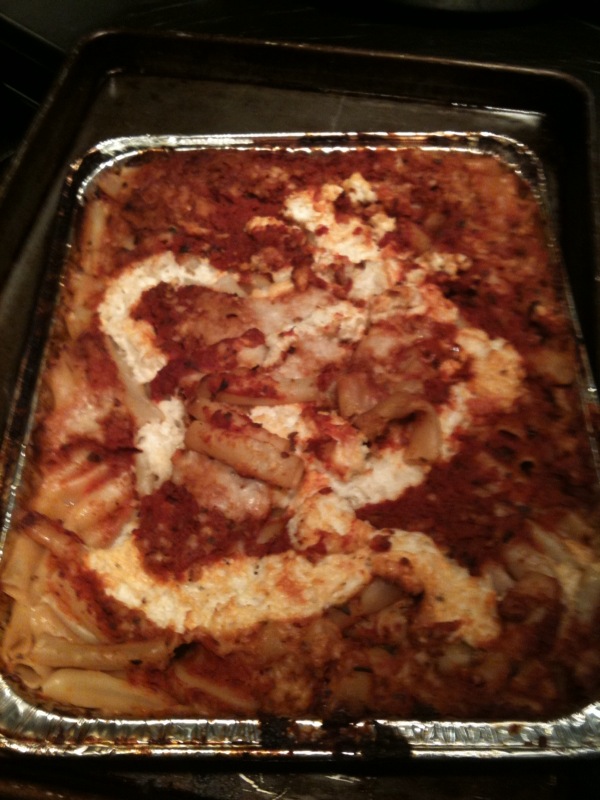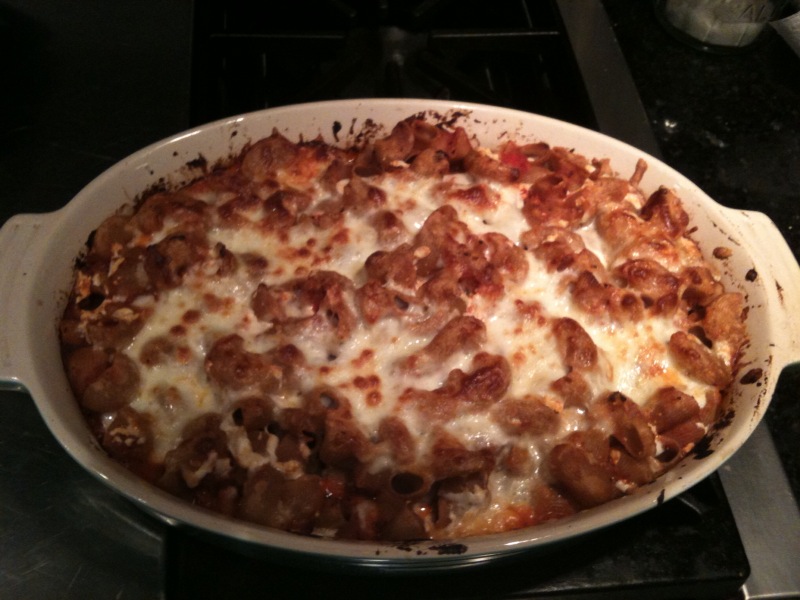A few weeks ago I made ziti for dinner. It's an Italian staple for many reasons; it's cheap, it's easy, and it's delicious. I made it with organic whole wheat pasta and smoked mozzarella, and my whole family devoured it.
But then I had an idea for an experiment. How would my homemade organic ziti compare in taste and price to either homemade chemical or frozen processed ziti? I was especially interested in price, since I am constantly asked why organic is so much more expensive than chemical food. But as the publisher of the great Eat This, Not That series, I was also curious to find out if there are any hidden fats, sodium differences, or calorie surprises between the alternatives. And since I have a new blog helper, Dana Blinder, to assist me on projects like this, we set a date for my house after work one night (in yes, the real Maria's Farm Country Kitchen) to perform our ziti experiments. This wasn't a science lab analysis, it was a kitchen lab analysis -- armed with tablets, pencils, calculators and two hungry kids (four if you include us -- I think my husband was at a baseball game during the cooking, but rest assured, he ate all the leftovers), we compared nutrition analyses and prices and flavor.
We cooked two zitis: my homemade (this time just with regular mozzarella) and a Celatano's frozen white pasta ziti.

Frozen ziti
The first finding was that homemade was actually faster than frozen. A large (serves 9) frozen ziti takes more than an hour and a half in the oven -- and it's packed in tinfoil, so there was no cheating with microwaving. Homemade, including boiling water and cooking pasta beforehand, only took an hour (because the pasta is already hot, you only need to bake it for a half hour).

My fresh, organic ziti
The second finding is that between all three (organic, chemical homemade, frozen) there weren't major differences in calories, fat, sodium, and so forth. The biggest difference was that the store-bought chemical pasta sauce [brand?] is higher in sodium than the store-bought organic pasta sauce [brand?], and whole wheat pasta is higher in fiber than white. But after doing all the math (and getting my math genius daughter to help out), I recalled a recent quote by Cheryl Forberg on my blog: "The quality of the calories is as important as the quantity." So, while you are getting the same amount of calories from all versions, with the organic version you are NOT getting toxic chemicals, unpronounceable additives, and a trail of destructive farming practices.
What about the taste? Well, my version was done first, and we were all starving, so we ate good portions of my whole wheat organic ziti. The kids ate all their food and did not complain, and enjoyed it. When the frozen, chemical ziti came out of the oven, it was a bit of a novelty for my kids, since we hardly ever have food like that in my house. While it looked like crap (the top stuck to the lid and it looked like a train wreck) it tasted soft, squishy, salty, and buttery -- kind of like white Italian bread with butter, which tastes awesome while you are eating it but leaves you feeling constipated the next day (and starving an hour after you eat it). With the honesty of a 3-year-old, Lucia said she definitely preferred the frozen to homemade. But she also prefers candy to vegetables, if offered. That doesn't mean I allow it, or that it's good for her.
The biggest surprise was the price difference. We added up the prices, divided by serving size and came up with the following per-serving breakdown:
Organic ziti with whole wheat pasta: $1.87
Non-organic ziti with whole wheat pasta: $1.64
Non-organic ziti with white pasta: $1.41
Frozen non-organic ziti: $1.33
As Dana said afterward, "Cooking an organic dinner is not unreasonable, and you are not going to break the bank to go organic." So a wholesome, organic, high-fiber, and nutritious dinner can be had for about .50 cents more per person than a toxic, chemical, processed dinner. Add a salad and you might up that price differential to a dollar -- but that dollar a day will keep the doctor away!
Having said that, as some of you know from reading my book, Organic Manifesto, I don't believe that people should have to pay more for organic. The fact that chemical food is cheaper stems primarily from government subsidies that support cheap chemical wheat (pasta) and cheap bovine growth hormone and antibiotic-fed dairy cows (cheese).
Let's be honest: I wish I could say that my 3-year-old preferred my ziti to the frozen boxed ziti, and that, surprisingly, my organic ziti was cheaper than the others. But I can't. But what I can do is share my fairly yummy, high-fiber, and organic ziti recipe with you, for a meal that your kids will eat and that will leave you feeling full and satisfied.
So check back here on Friday for my recipe. In the meantime, I want to know which you would rather eat: Go to Maria's Farm Country Kitchen to cast your vote!
Related Links:
Finding a Great Recipe while Lost in Harlem - Maria's Farm Country Kitchen
Organic Manifesto - Rodale.com
People Think "Organic" Means Low-Calorie - Organic Authority
For more from Maria Rodale, go to www.mariasfarmcountrykitchen.com.
